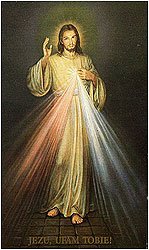St. Faustina and the Feast of Divine Mercy
 Today is the First Sunday after Easter--the Feast of Divine Mercy. It was instituted in 2000 by Pope John Paul II, following instructions in the diary of Sister Mary Faustina Kowalska, whom he canonized in that year.
Today is the First Sunday after Easter--the Feast of Divine Mercy. It was instituted in 2000 by Pope John Paul II, following instructions in the diary of Sister Mary Faustina Kowalska, whom he canonized in that year.Helena Kowalska, born in Poland in 1905, felt her vocation to become a nun at the age of seven, but was never encouraged by her parents. She had only three years of schooling before leaving home to seek work as a domestic in order to help her very poor family. Only after Jesus came to her in a vision, asking her why she was not yet doing His work, did she run away from home and join a convent, the Sisters of Our Lady of Mercy.
At the convent, because of her lack of education, she continued to be assigned menial work. She also continued receiving visions, revelations, hidden stigmata, participation in the Passion, and other extraordinary gifts. At the instruction of the Lord Jesus and her confessors, she kept a diary, and Jesus referred to her as his "secretary."
One of the instructions she received was to institute a feast day dedicated to the Divine Mercy. Another was to found an apostolic movement of the Divine Mercy. She was continually thwarted by her efforts, however, as she was uneducated and never taken seriously by most of her superiors. She died of tuberculosis in 1938 at the age of 33.
Her spiritual director, Father Sopocko, tried to continue her work, and in 1941 an Institute of Divine Mercy was founded. In 1958, however, theologians exaining her Diary declared it heretical; the Holy See condemned the Institute and suppressed all of Father Sopocko's work.
Enter Karol Wojtyła, fellow Pole, Archbishop of Kraków and the future Pope John Paul II. He had her Diary re-examined by scholars who took into account her poor spelling and faulty grammatical constructions. Devotion to the Divine Mercy was once again permitted, and in 2000, Saint Faustina was canonized and Divine Mercy Sunday replaced Low Sunday as the feast of the first Sunday following Easter.
In 1931, Sister Faustina was instructed in a vision to have a portrait painted of Jesus as she saw Him at that moment. She saw a red and a white ray emanating from the heart of Jesus. According to Faustina's Diary, Jesus told her, "The two rays denote Blood and Water. The pale ray stands for the water which makes souls righteous. The red ray stands for the Blood which is the life of souls."
In 1934, a local artist of Vilnius, Eugene Kazimirowski, painted the image under her direction. Although there exist today several portrayals of the Divine Mercy, the Vilnius Image is the original and most famous. It has been suggested that the face of Jesus in the Vilnius Image exactly matches that of the Shroud of Turin.
Labels: art, Eugene Kazimirowski, St. Faustina


0 Comments:
Post a Comment
<< Home